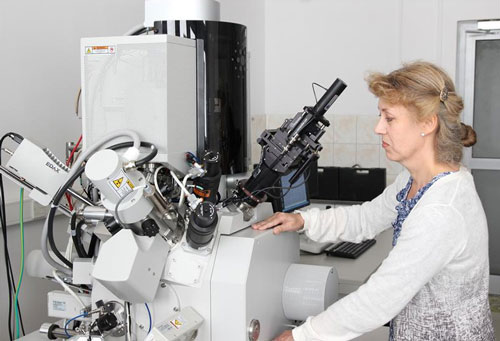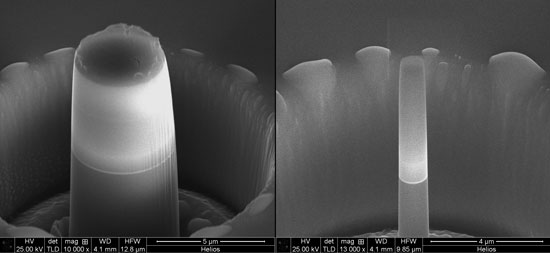| Jun 20, 2011 |
Nanotechnology at University of Warsaw gets rare dimensional nanostructure-generating equipment
|
|
(Nanowerk News) State-of-the-art Dutch focused ion beam (FIB) milling equipment launched at the Faculty of Physics, University of Warsaw (FUW) has made it possible to produce first micropillars, microscopic semiconductor structures that can be used as efficient light sources.
|
|
"Being able to generate micropillars directly in the University laboratories is of key importance to our research, especially as regards works on really efficient yellow laser light sources," says Wojciech Pacuski, PhD, (FUW). The equipment purchased by the Institute of Experimental Physics FUW is one of only a handful of such devices in Poland.
|
|
Micropillars are a variety of optical microcavities, structures in which photons are confined for a relatively long time in a small volume. Micropillars are obtained by milling a surface that was previously constructed out of many layers of semiconducting materials with carefully selected characteristics. "The surfaces out of which we are currently fabricating micropillars were made at the University in Bremen. Soon, we will be able to make them here as well with the aid of another acquisition of the Faculty, currently being installed – molecular beam epitaxy (MBE) equipment," says Tomasz Jakubczyk, PhD student at the Solid State Physics Division of the Institute of Experimental Physics FUW.
|
 |
| Jolanta Borysiuk, PhD, FUW during the venting of the focused gallium ion beam milling equipment.
|
|
In order to build a micropillar, scientists need to remove material from the surface with precision, in such a way as to create a pillar of diameter and height of the order of micrometers. Helios NanoLab device, which allows milling of a surface with a beam of gallium ions, is used for that purpose. After being accelerated to high energy, ions are focused to an accuracy of several nanometres and directed towards selected points of the surface. Given their considerable size and mass, gallium ions do not penetrate inside the material, but rather sputter atoms from its surface. The sputtered atoms disperse in the vacuum chamber. The effects can be immediately assessed by means of a scanning electron microscope, which is an integral part of the device. Apart from micropillars, it is possible to generate other dimensional semiconductor structures using this method.
|
|
The five million zlotys' worth of focused ion beam milling equipment was purchased as part of the Centre for Preclinical Research and Technology project, co-financed under the European Regional Development Fund as part of the Operational Programme Innovative Economy 2007-2013. "The equipment will be available not only to scientists, but also to students from the Faculty of Physics UW specializing in condensed matter physics, including those who pursue the recently introduced nanostructure engineering interdisciplinary studies," stresses Pacuski, PhD.
|
|
Micropillars have many modern applications, especially in constructing single-photon sources and generating entangled photon pairs. Sources of this type are used, among others, in works on optical and quantum computers and in quantum cryptography.
|
 |
| "First micropillars generated at the Faculty of Physics, University of Warsaw. An electron microscope image.
|
|
Scientists from the Faculty of Physics, University of Warsaw are particularly interested in micropillars containing quantum dots. "Quantum dots themselves are good sources of single, and even entangled photons, but the desired characteristics are additionally enhanced when they are placed inside micropillars. A micropillar with quantum dots can, for example, emit single photons more frequently," explains Jakubczyk.
|
|
Physicists from the University of Warsaw intend to use the new equipment to construct micropillars that are sources of yellow laser radiation. "With a method devised by Pacuski, PhD, in collaboration with colleagues from Bremen and patented in 2009, we can create mirrors, which are a crucial element of a laser, on both ends of micropillars. The fact that we are one of a handful of laboratories in the world specializing in materials from the II and VI group of the periodic table is an additional asset in works on a yellow laser. These compounds emit light precisely in the wavelength range corresponding to yellow light," says Jakubczyk.
|
|
Microlasers emitting yellow light will be built as part of the "Lider" project. They may be useful in those fields of telecommunication that make use of plastic optical fibres, which attenuate yellow light the least. Increasingly popular displays offering an additional range of colours (other than the standard RGB) also rely on yellow lasers.
|
|
"We try to get students involved in our research into new solutions already at the early stages of their academic studies," says Andrzej Wysmotek, PhD, vice dean of FUW. Already students of first degree studies have a chance to be a part of pioneering research.
|


